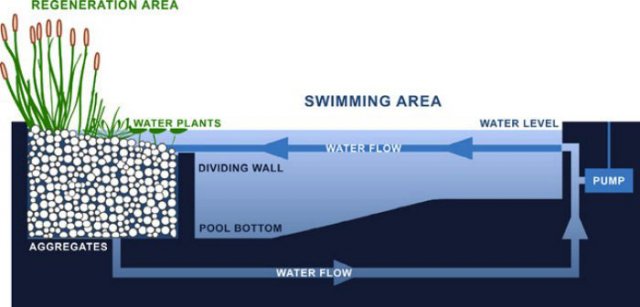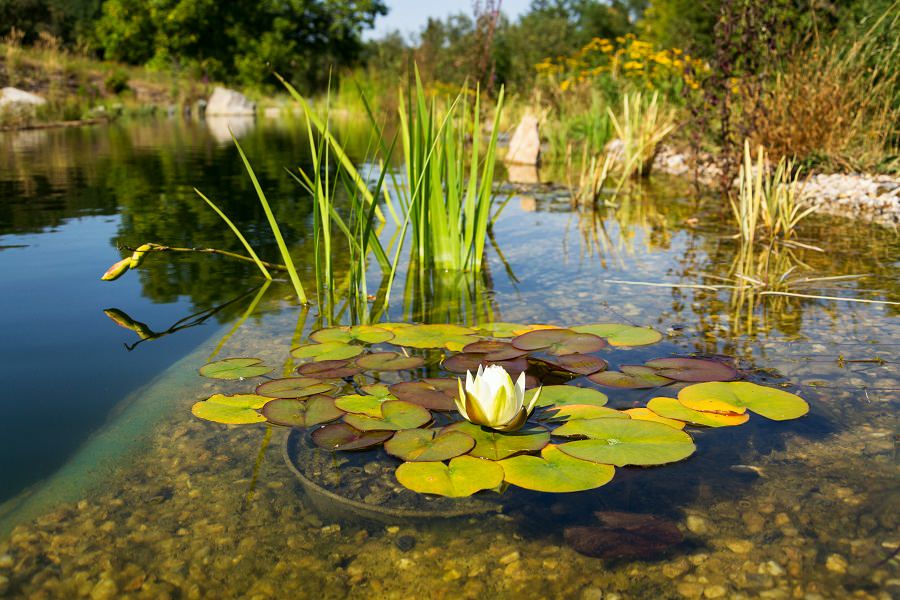The use of chemicals to clean swimming pools has led to more organic and healthier methods for keeping your swimming pool clean. One unique approach is called a natural swimming pool that works like a small ecosystem built in your backyard using no chemicals or energy but still provides your family a place to cool off all summer long. What is a backyard natural swimming pool?
A Natural Backyard Swimming Pool is designed to work without chemicals & instead uses a ‘regeneration zone’ where pool H2O is cleansed biologically by micro-organisms living on water plant roots & media eliminating nutrients that cause algae & removing contaminants leaving H2O crystal clear water.
These pools have been found in ancient civilizations for religious and social purposes dating back to the early Egyptians in 2500 BC, and the Palestrae of Ancient Greece. Now they are making a comeback. The naturally organically cleaned water in a Natural Swimming Pool is so healthy you can drink it!
What is a Natural Pool
A Natural Backyard Swimming Pool or Pond is designed for swimming, in a natural environment. The water is cleansed biologically (by plants and micro-organisms) and with physical filters, but without chlorine, ozone, copper compounds, UV radiation, or ultrasonic devices, which are undesirable because they reduce the biological activity that a natural pool is intended to encourage. Microbes on plant roots and stones remove nutrients and contaminants, and free-swimming micro-organisms eat algae.
Unlike normal chlorine and salt backyard swimming pool, a Natural Swimming Pool or Pond doesn’t use chemicals to treat the pool water. There are no mechanical filtering systems and store-bought chemicals stored on-site to adjust the chemistry of your pool. This eliminates electrical and maintenance costs along with the time you put in to keep up with it.
The swimming pool’s water is cleaned by mimicking a pond in nature through biological treatment. Microbes growing on plant roots and stones remove nutrients and contaminants, and free-swimming micro-organisms eat algae.

Natural swimming ponds have separate zones for swimming and water purification. Designs can vary, as well as the recommended sizes and ratios depending on your needs and desires. One side is dedicated to the Swimming area and the other zone, a Regeneration Zone is dedicated to filtering the entire Natural Pool.
This zone contains plants and other aquatic life that naturally occurs in an ecosystem. These Natural Ponds demand less maintenance than a conventional swimming pool with beautiful designs that bring a natural environment to you into your own backyard.
Small Airlift pumps can be used to circulate the water in the swimming pool that will move water throughout the zones and ensure adequate mixing happens along with adding oxygen to the Regeneration Zone. These pumps are normally powered by solar power making for an effortless system. Aeration is delivered by small bubbles from an air stone that diffuses the air adding oxygen like in an aquarium.
Like any swimming pool, natural pools can be a potential safety hazard and may be subject to municipal regulations. Before undertaking a Natural Swimming Pool, make sure to check any legal responsibilities, as pools may require safety fencing depending on depth.
It won’t take long before your own ecosystem takes hold in your own backyard.
- A few days after filling the pool, you might get an algal bloom that could make the water murky
- The first microscopic animals such as water fleas and daphnia will appear to eat the algae and the pool will clear again.
- Their predators – water insects and arthropods will come after them
- Pond skaters walk over the water surface thanks to their hydrophobic feet
- Great diving beetles fly in, as do whirligig beetles on the surface of the pool
- Later, dragonflies will lay their eggs, and their larvae will go hunting in the ecosystem
- Later still, frogs and toads will find their way overland to lay their eggs.
Natural Swimming Pool Plants
Water plants are important for filtering in natural pools. This includes a densely planted area with submerged plants and floating-leaf plants. Plants will withdraw nutrients, that keep algae from flourishing and depleting oxygen levels, providing a habitat for beneficial micro-organisms that kill pathogens.
In an ecosystem, wetland systems are known as the (kidneys of the earth) because of how they clean water. In a Natural Swimming Pool or Natural Swimming Pond pristine clean water is needed especially when this water will be used for recreational swimmers.
This is a living ecosystem that will support life starting with beneficial microorganisms that breaks down nutrients available for algae growth by feeding on bacteria. Because it’s a living ecosystem it will need oxygen to support life which plants in the Regeneration Zone provide. Plants provide oxygen by photosynthesis. Some plants can do this better than others.
Three kinds of plants typically regulate the natural cycle of swimming ponds:
- 1) Floating plants: Water lilies and other floating plants rooted in the bottom provide shade and protect micro-organisms from UV rays.
- 2) Oxygenating plants: By absorbing nitrates and phosphates, submerged and free-floating plants contribute to the ecological balance of the pool and play an important role in slowing the growth of algae.
- 3) Biological filters: As water passes through the fibrous root structure of plants, micro-organisms concentrated in the root system act as a natural filter, removing contaminants and excess nutrients from the water.
Other water plants needed for your natural swimming pool are the same plants that grow in wetland areas and are mostly helophytes such as Vetevers, common reeds, cattails, and irises or sedges. Roots and rhizomes keep the filter aggregate permeable for water percolation and promote the development of beneficial micro-organisms. As long as the plant has a long root system then it can work well as a filter in a natural pool.
Besides the water plants that are living in an organic swimming pool, there are some other small creatures that are necessary for this man-made biosphere that you have created.
- Aquatic life – insects, snails, and amphibians: they feed on each other, and ensure healthy water and the charm of a natural pond.
- Daphnia: These microscopic creatures are common in most lakes and ponds. They play an important role in regulating the cycles of nitrates, phosphates, and phytoplankton. They are predators of bacteria and are an important source of food for other aquatic life.
Natural pools offer the right environment for “beneficial bacteria, zooplankton, and phytoplankton to extract these naturally occurring nutrients. Because nutrients are the enemies in any natural organic wetland. Too much oxygen is robbed from the water.
Natural Pool Maintenance
Natural Swimming pools require less maintenance than a traditional chlorine swimming pool since they’re largely self-cleaning. You won’t need to buy or mix pool chemicals. Some maintenance for a natural pool is the same as a traditional pool, such as sweeping the walls or vacuuming the bottom. Some of it isn’t, like pruning the wetland plants in the regeneration zone and thinning out the wetland area and Regeneration Zone.
Is it necessary to test your Natural Swimming Pool? No, this is actually not necessary because your pool is chemical-free. However, if you’d like to test your pool water’s natural PH there are many kits that you can purchase.
Have a Great Summer!
JimGalloway Author/Editor

References: Natural Swimming Pools
EcoHome–Natural Pools
